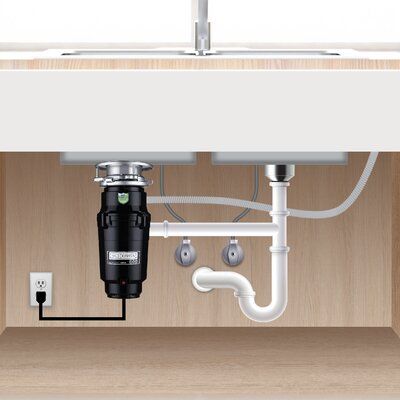
Garbage Disposal Repair, Plumbing & Installation Services
Garbage disposals are indispensable appliances in modern kitchens, providing a convenient way to dispose of food waste and maintain clean and hygienic kitchen environments. However, like any other household appliance, garbage disposals can experience issues such as jams, leaks, or malfunctioning components that require repair or replacement. As a trusted provider of plumbing services in the Saint Pete area, Saint Pete Plumbing is committed to delivering expert guidance and assistance for garbage disposal repair, plumbing, and installation. In this comprehensive guide, we will explore the intricacies of garbage disposal repair, plumbing, and installation, covering common problems, troubleshooting techniques, repair procedures, and installation tips to help homeowners and property managers maintain functional and efficient garbage disposal systems.Understanding Garbage Disposals:
Garbage disposals are electrically powered devices installed beneath kitchen sinks that shred and grind food waste into smaller particles, which can then be washed away through the plumbing system. A typical garbage disposal unit consists of the following components:Grinding Chamber:
The grinding chamber is the main compartment where food waste is deposited and ground into smaller particles by rotating blades or impellers.Motor:
The motor powers the blades or impellers inside the grinding chamber, providing the necessary torque and speed to shred food waste effectively.Flywheel:
The flywheel is a heavy, rotating disk connected to the motor shaft that helps maintain momentum and balance during operation.Impellers or Blades:
Impellers or blades are located inside the grinding chamber and are responsible for shredding and grinding food waste into smaller particles.Hopper:
The hopper is the opening at the top of the garbage disposal where food waste is inserted for grinding.Common Garbage Disposal Problems:
Garbage disposals may encounter various issues over time due to factors such as improper use, mechanical wear, or plumbing system issues. Some common garbage disposal problems include:Jams:
Jams occur when food waste becomes lodged between the impellers or blades inside the grinding chamber, preventing the disposal from operating properly.Leaks:
Leaks may develop in the garbage disposal unit or associated plumbing connections, leading to water damage and potential mold or mildew growth.Clogs:
Clogs can occur in the drain line or plumbing system downstream from the garbage disposal, resulting in slow drainage or backups in sinks and drains.Strange Noises:
Grinding, rattling, or humming noises during operation may indicate mechanical issues such as worn-out bearings, loose components, or foreign objects inside the disposal.Foul Odors:
Foul odors emanating from the garbage disposal or sink may be caused by food residue buildup, bacterial growth, or other hygiene-related issues.Troubleshooting Garbage Disposal Problems:
When faced with garbage disposal issues, homeowners can perform some basic troubleshooting steps to identify and address the problem:Reset the Disposal:
If the garbage disposal stops working or makes a humming noise, it may have tripped a reset button or overload protection feature. Locate the reset button on the bottom or side of the disposal unit and press it to reset the motor.Clear Jams:
If the garbage disposal is jammed, turn off the power to the disposal unit and use a hex wrench or disposal wrench to manually rotate the impellers or blades inside the grinding chamber. This may help dislodge any trapped food waste and restore normal operation.Check for Leaks:
Inspect the garbage disposal unit and associated plumbing connections for signs of leaks, such as water puddles or moisture buildup. Tighten any loose connections or fittings and replace damaged seals or gaskets if necessary.Remove Clogs:
If the drain line or plumbing system is clogged, use a plunger or plumbing snake to clear the obstruction and restore proper drainage. Avoid using chemical drain cleaners, as they can damage garbage disposal components and pipes.Clean the Disposal:
To eliminate foul odors and bacterial growth, clean the garbage disposal unit regularly by grinding ice cubes, citrus peels, or baking soda and vinegar. This helps remove food residue and debris from the grinding chamber and neutralizes odors.Garbage Disposal Repair Procedures:
For more complex garbage disposal issues, homeowners may need to disassemble the unit and replace malfunctioning components. Here’s a step-by-step guide to common garbage disposal repairs:Turn Off Power:
Before starting any repair work, ensure that the power to the garbage disposal unit is turned off at the circuit breaker or electrical panel.Disconnect Drain Line:
If necessary, disconnect the drain line from the garbage disposal unit to access the internal components. Use pliers or a wrench to loosen the hose clamp and carefully remove the drain line.Remove Mounting Screws:
Loosen the mounting screws or brackets securing the garbage disposal unit to the underside of the sink. Support the disposal unit with one hand while removing the mounting hardware with the other hand.Inspect Impellers or Blades:
Once the disposal unit is removed from the mounting assembly, inspect the impellers or blades inside the grinding chamber for signs of damage, wear, or obstruction. Use a flashlight to illuminate the inside of the chamber and remove any lodged food waste or foreign objects.Replace Components:
If the impellers or blades are damaged or worn out, remove them from the disposal unit and replace them with new ones. Follow the manufacturer’s instructions for proper installation and alignment of the replacement components.Reassemble and Install:
Once the repair work is complete, reassemble the garbage disposal unit and reinstall it in the mounting assembly under the sink. Tighten the mounting screws or brackets securely to ensure a stable and secure installation.Reconnect Drain Line:
Reconnect the drain line to the garbage disposal unit and tighten the hose clamp securely. Ensure that the drain line is properly aligned and free of kinks or obstructions.Test Operation:
Turn on the power to the garbage disposal unit and test its operation by running water and activating the disposal. Listen for any unusual noises or vibrations and check for leaks or drips around the unit.Garbage Disposal Installation Tips:
Installing a new garbage disposal can be a straightforward task with the right tools and techniques. Here are some tips for a successful garbage disposal installation:Choose the Right Size:
Select a garbage disposal unit that is compatible with your sink and plumbing system. Consider factors such as horsepower, grinding capacity, and noise level to choose the right size and model for your needs.Gather Tools and Supplies:
Before starting the installation, gather all necessary tools and supplies, including a screwdriver, pliers, wrench, plumber’s putty, and electrical tape.Turn Off Power and Water:
Shut off the power to the garbage disposal circuit at the electrical panel and turn off the water supply to the sink before starting the installation.Remove Old Disposal:
If replacing an existing garbage disposal, disconnect the power and drain lines from the old unit and remove it from the mounting assembly under the sink.Prepare Mounting Assembly:
Clean the mounting assembly under the sink and inspect it for any signs of damage or corrosion. Replace any worn-out or damaged mounting hardware as needed.Install New Disposal:
Follow the manufacturer’s instructions for installing the new garbage disposal unit, including mounting it securely to the underside of the sink and connecting the drain line and power supply.Seal Connections:
Apply plumber’s putty or silicone sealant to the flange of the garbage disposal unit before installing it in the sink drain opening. This helps create a watertight seal and prevents leaks.Test Operation:
After completing the installation, turn on the power and water supply to the garbage disposal unit and test its operation by running water and activating the disposal. Check for leaks, drips, or unusual noises and make any necessary adjustments.Garbage disposal repair, plumbing, and installation are essential aspects of maintaining functional and efficient kitchen environments. By understanding the components of garbage disposals, troubleshooting common problems, and following proper repair and installation procedures, homeowners and property managers can ensure the reliable operation of their garbage disposal systems. Saint Pete Plumbing is dedicated to providing expert guidance and services for garbage disposal repair, plumbing, and installation, helping individuals in the Saint Pete area maintain clean and hygienic kitchen spaces. With the right knowledge and techniques, anyone can master the art of garbage disposal repair and installation and enjoy the convenience of efficient food waste disposal in their home or commercial kitchen.





